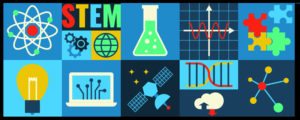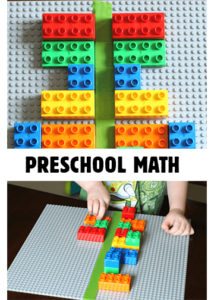
As a parent, you are your child’s first teacher. The learning environment you create at home for your preschooler today can go a long way in preparing them for success in the classroom.
This is especially true for STEM subjects (science, technology, engineering and math). If that sounds intimidating, especially if these were not your strong suit, don’t let it be. Much like reading picture books builds early literacy skills, there are lots of fun and kid-friendly activities that a parent can do to establish those foundational STEM skills before they start kindergarten.
![]()
STEM’S IMPORTANCE TO THE WORKPLACE OF THE FUTURE
First, a big-picture view. If your child starts with a good foundation of STEM subjects, that can set them up for long-term academic success. Trends from the past 30 years and near-term projections tell us there are ample career opportunities for those with strong skills in mathematics, engineering, science and technology.
* The number of U.S. STEM workers has nearly doubled. Between 1980 and 2015, we’ve gone from an 11.5 million STEM workforce in the U.S. to one of 20.4 million strong, according to a report by the American Immigration Council. The data also shows that highly educated workers born outside of the U.S. are filling the increased demand for STEM jobs. Back in 1990, 10.6 percent of the U.S. STEM workforce was foreign born, while in 2015, that share had nearly doubled to 19.3 percent.
* STEM jobs continue to emerge. More recently, between May 2009 and May 2015, STEM occupations grew at a rate of 10.5 percent, compared to the 5.2 percent growth in non-STEM occupations, with the highest gains in computing and engineering occupations, says the Bureau of Labor Statistics.
* This above-average growth is expected to continue at a rate of 8.9 percent between 2014 and 2024, versus the 6.4 percent rate for non-STEM jobs, according to the U.S. Department of Commerce.
* Most STEM jobs draw on a highly educated, well-trained workforce. Ninety-nine percent of STEM professions require post-secondary training or education, according to the Bureau of Labor Statistics.
* STEM careers translate into higher-than-average-paying jobs. Ninety-three out of 100 STEM jobs have higher wages than the national average, at $87,570 versus $45,700, according to the BLS.

* Count as you go: Counting to 10 is great, but kids need to understand the function of numbers, or it will just be a string of memorized words. As much as possible, count the physical objects around you, whether it’s apple slices at snack time or counting the stairs when heading for bed. When the counting is well established, bump it up a notch and start simple addition and subtraction with the physical objects. (“Let’s say you eat two apple slices. How many are left?”)
* Find the shapes: Whether at home, waiting for a restaurant table or passing time before a doctor’s appointment, search for shapes in the room. (“Look, that door is shaped like a rectangle. That table is a circle.”)
* Invent a movement game: Put comparison and spatial concepts into motion during the next session at the park. (“Choose the shortest slide.” “Take three giant steps forward.” “Hop 12 times.”)
* Three more sleeps: Borrow a page from the Advent tradition and create a countdown calendar to an outing or a special event.
* Watch the moon: When the lunar timing is right, step outside after dinner or before bedtime and keep a simple moon log in a calendar with big spaces. Take note of whether it’s higher or lower in the sky compared to the night before, and keep track of how it appears to change shape.
* Pattern play: Together, stamp a pattern of alternating designs on a slab of rolled-out Play-Doh, or build a block or LEGO Brick tower with alternating colors, and gradually increase the number of elements in a pattern.
For more ideas and activities, check out our blog with quick and fun math activities for preschoolers.
EARLY SCIENCE
As you may suspect, learning science during preschool isn’t about learning facts and memorization. It’s about understanding how real-world concepts work, like water, motion and manipulation. That means if things get messy, that’s perfectly OK!
As one educator put it, “The nature of science itself is: Make observations of the natural world, try and identify patterns, ask questions, find answers, ask more questions,” he explains. “It’s solving. It’s a way of thinking.”
That level of investigation and exploration just so happens to come naturally to young children. What’s more, research shows that playing and having real-world interactions builds valuable connections in the brain. Later on, in the classroom, you’ll have provided them deep context from which they can draw.
* Build a water table. Here’s our blog with three fun ideas on how to explore water with your preschooler.
* Plant seeds in a paper cup and watch them grow.
* Go outside, have nature walks, or just hang out and let them freely explore.
* Experiment with color mixing using bowls of water and food coloring.
* Get touchy-feely, and create sensory bins. Many ideas can be found here to get you started.
* Visit science museums geared for children. We have lots of tips to help you plan your trip.
* Play with playground physics.
EARLY ENGINEERING
For generations, building and construction toys have had a ubiquitous presence in play sets. But more recently, parents and educators have become more aware of the meaning and purpose behind this form of play. Building toys give children a safe and fun way to design and build objects, scenes and cityscapes. Later on, these benefits happen to show up in the classroom, as well. Here’s what the research tells us:
* Building from a model improves spatial skills.
* Kids who play with building toys during preschool have higher scores in elementary school math.
* In addition to those academic benefits, construction toys teach many soft skills that are essential to functioning in the classroom, such as determination, cooperation and problem solving.
Bottom line, those sets of LEGO Bricks have tremendous value!
One of the fun things about construction toys is having a chance to build your own playthings, even if they only last a few hours.
* Build and race cars from LEGO Bricks.
* Using toothpicks and gumdrops (or marshmallows), piece together structures and shapes.
* Build a homemade marble run with everyday materials.
* Put together one of these on-the-go activity kits to keep little hands busy during outings.
There are literally thousands of at-home building activities online. Be prepared for those moments when inspiration hits and set aside some closet space for a DIY maker station.
The path to lifelong learning starts now
Life is long, and this blog isn’t meant to define a single path to engineering school. STEM activities benefit all children, no matter which passions and pursuits they take up as they learn and grow. In the meantime, keep it real and keep it fun. For more ideas, be sure and stay in the know about the hands-on preschool workshops designed by Bricks 4 Kidz, where they learn, build and play with fun projects made from DUPLO Bricks you won’t find in any toy store.